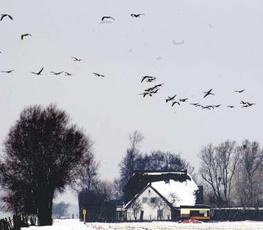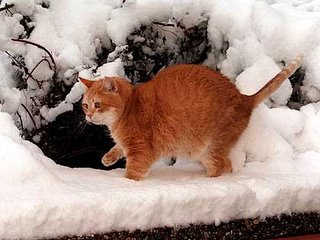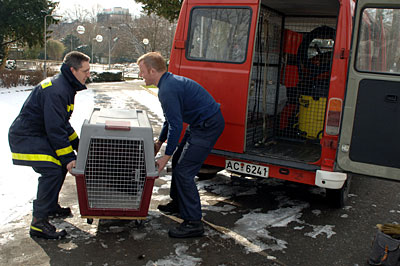Vogelgrippe Claims the Life of a Kater on Deutschland's Rügen Islet. Could Humans Be Next?

A tomcat who died last week on Deutschland's Ostsee Islet of Rügen was killed by the deadly Vogelgrippe virus H5N1. Der Kater, who had been recently adopted by Rentner Johannes Lammertz, 62, of the Schaprode section of Rügen after his previous owner had died, was found dead in a Brennholz-Schuppen on Lammertz's Anwesen (See photo on the right).
The nameless gray and white cat's death was unexpected in that he did not exhibit any of the symptoms commonly associated with Vogelgrippe, such as labored breathing, nasal discharges, and sneezing. It is believed that the cat contracted the virus from eating birds already infected with it.
Despite the dire prediction of Dutch researcher Thijs Kuiken back in 2004, there have not been so far any recorded instances of the virus being passed either between cats or from cats to humans. However, when a cat at an animal sanctuary in the southern Austrian city of Graz tested positive for Vogelgrippe earlier this week but did not get sick, the World Health Organization (WHO) became concerned. The organization's Michael Perdue told Reuters on March 7th that this ominous development could mean that the virus is mutating into a far more dangerous strain which could infect humans.
While admitting that there is not any current research which shows cats to be hidden carriers of the disease, Perdue added, "The longer it stays in mammals one would assume it is more likely to be adapted to mammals, as opposed to staying in birds. If the virus obtains all the mutations needed to transmit easily between mammals it could imply a higher risk to humans." The infected cat in Graz was one of one-hundred-seventy felines who were carelessly caged next to swans, chickens, and ducks with Vogelgrippe.
For the past few weeks at least three-hundred-sixty-four Soldaten dressed in biohazard suits from the Bundeswehr (See photo below) have been pressed into service on Ruegen collecting the corpses of more than three-thousand mute swans and song birds who have died on the island. Tests conducted on a sampling of the corpses by the Friedrich Loeffler Institut have revealed that more than two-hundred of them died from Vogelgrippe. The virus has also been discovered in the Deutschland states of Bayern, Baden Wuerttemberg, Brandenburg, Schleswig-Holstein, Mecklenburg-Vorpommern, and Niedersachsen.

The spread of the virus from birds to mammals has prompted health officials to order that all cats living within three kilometers (1.8 miles) of an infected area be confined indoors. Although there is no evidence that dogs are susceptible to the disease, the government has ordered that they be kept on a leash in infected areas. Other experts have advised that cats with runny noses and colds be taken immediately to a vet and checked for the virus (See photo below of a cat being examined). Professor Peter Openshaw, head of respiratory infections at London's Imperial College has even gone so far as to recommend that a vaccine be developed for cats. (See BBC, March 1, 2006, "Bird Flu: Are Pet Cats at Risk?")
In Deutschland, it is legal for hunters to kill cats that stray more than two-hundred meters (216 yards) from a built-up area and the Association for Animal Protection estimates that 400,000 Katzen are slaughtered in this manner each year. (See London's Telegraph, October 23, 2005, "German Hunters Under Fire for Killing Domestic Cats.") Now, some Tierschutzen fear that the hysteria occasioned by Vogelgrippe could lead to more of Deutschland's 7.5 million felines being gunned down by ailurophobes. (See photo below of a cat walking in the snow.)

This is not the first time that domestic cats have become infected with Vogelgrippe. In Thailand in 2004, two domestic cats, along with one-hundred-forty-seven tigers at a private zoo, died from the virus. In both cases, the cats were fed contaminated chicken.
Civet cats, blamed for the spread of SARS, and leopards have also succumbed to Vogelgrippe. Cats are also susceptible to the feline version of BSE and around one-hundred of them died from the disease in England during the 1990s. The actual number of fatalities was probably much higher because only a fraction of aggrieved cat owners were willing to spring for postmortems. Back then, the culprit was contaminated beef contained in commercial cat food.
In addition to dogs, rats, rabbits, guinea pigs, and hamsters are believed to be immune to Vogelgrippe. The virus has also been found in ferrets and pigeons but the latter rarely transmit the virus. Many virologists feel that the real danger to man comes from pigs who, because of genetic similarities, could provide a mixing bowl for gene swapping which could lead to the creation of a new highly contagious strain of the disease which could be passed not only from pigs to man but from man to man.

Since 2003, one-hundred-seventy-three cases of Vogelgrippe have been reported in humans worldwide, ninety-three of which have been fatal. With the exception of a handful of cases where human-to-human transmission of the virus is suspected, all of the reported cases have involved birds, primarily migratory birds, chickens, and ducks.
In most cases, the victims became infected through either coming into contact with bird feces or by eating dishes which contained raw poultry blood. Apparently, even contaminated poultry can be safely eaten so long as it is thoroughly cooked.
It is believed that the virus is transmitted by wild birds to chickens and turkeys kept outdoors and then on to humans. This has led agricultural officials in Deutschland and elsewhere in Europe to order that all poultry be confined indoors.
Unsanitary conditions on poultry farms (See Washington Post, February 5, 2005, "As SE Asian Farms Boom, Stage Set for Pandemic."), itinerate duck herders (See Washington Post, February 13, 2005, "Thai Farmers Worry Controls on Bird Flu Threaten Livelihoods."), and unhygienic cockfighting practices (See Washington Post, April 14, 2005, "Bird Flu Adds New Danger to Bloody Game.") have also been blamed for spreading Vogelgrippe. In the United States, fairly stringent sanitary regulations have been in place on U.S. poultry farms since the 1960s.
The outbreak of the virus has not only decimated the tourist business on Ruegen but it has also focused attention on the lack of preparedness on the part of Deutschland officials. For instance, the decontamination effort has been hampered not only by a shortage of such mundane items as biohazard gloves, plastic bags for carting away dead birds, and measuring cups for dispensing disinfectants, but also because of a shortage of ice sleds needed to retrieve carcasses from frozen lagoons. (See Der Spiegel, February 25, 2006, "Germany in the Age of Bird Flu.")
Fears have also been raised that football's World Cup, scheduled to be held in Berlin starting in June, may have to be cancelled. Meanwhile, ebay has been cashing in on the crisis by peddling mobile poultry enclosures, electronic scarecrows, and other anti-Vogelgrippe paraphernalia.
In Aachen, near the Dutch border, officials are becoming accustomed to receiving dozens of calls every day from frightened citizens beseeching them to come and collect dead birds. "Seit dem 21. Februar haben wir rund 90 Anrufer verzeichnet, die tot gefundene Vogel gemeldet haben oder Fragen zur Vogelgrippe hatten. Die Leute haben zum Teil richtig Angst," Hans Poth, Pressesprecher for the Nordrhein-Westfalen city told the Aachener Zeitung on March 3rd. (See "Vogelgrippe: Bei vielen liegen Nerven blank.") Two members of Aachen's Feuerwehr are shown below responding to another Fehlalarm.

While Openshaw, Kuiken, and the WHO paint a rather pessimistc view of the situation, Paul Hunter of the University of East Anglia does not think that Vogelgrippe is all that big of a deal for either cats or man. While admitting that the chances of a cat contracting Vogelgrippe are real, he does not think that they are "huge." As far as humans are concerned, he points out that while hundreds of thousands of people in Asia have handled infected poultry less than two-hundred have been sickened through such contact. (See BBC article cited supra.)
Although the experts may disagree about how much of a threat Vogelgrippe poses for cats and humans, there can be no disputing the Schaden that the virus has done to Deutschland's more than $2 billion a year poultry business and, as Hamlet would say, therein lies the rub. In the final analysis, it is man's insatiable greed which is to blame.
Factory farming is not only unhygienic, but it is also barbaric, cruel, and morally indefensible. Farm animals are not inanimate objects that man can genetically alter, mistreat, and slaughter at will without engendering all sorts of unintended calamities; they are instead living, sensitive beings who have just as much of a right to life as does man. Vogelgrippe and other zoonotic diseases, such as SARS, CJD, and AIDS, are the direct result of man's mistreatment of the animals.
In the best of all worlds, man would have a healthy respect for Mother Earth, the animals, and his fellows but, lacking that, the best that he can strive for is to behave in a halfway intelligent manner. Sadly, man's persistent mistreatment of the animals and Mother Earth proves over and over again that he has very little of either morality or brains.
Photos: Das Bild (Lammertz's farm), Deutsche Presseagentur (Bundeswehr), Associated Press (cat being tested and cat in the snow), and Aachener Zeitung (Feuerwehr).

<< Home